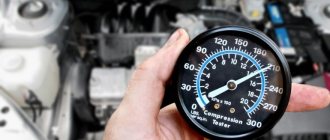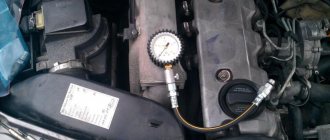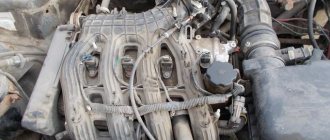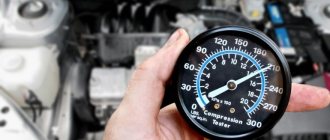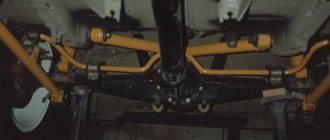05 February 2016 Lada.Online 76 494 10
How to quickly and accurately determine the condition of the engine? Check the compression in the cylinders! Is the engine running rough, you feel a loss of power, the consumption of engine oil or fuel has increased and the car has become difficult to start in cold weather? All of these problems may be caused by low compression in one or more cylinders.
Compression measurement
A compression test is carried out for a general assessment of the technical condition of the parts of the cylinder-piston assembly and the engine valve mechanism. The check is carried out with the engine warmed up to operating temperature. We increase the pressure in the engine fuel system (see “Replacing the fuel filter”) and do not replace the fuel pump fuse. We unscrew the spark plugs from the cylinder head (see “Checking the condition and replacing the spark plugs”). Disconnect the engine management system wiring harness assembly from the ignition coil wiring harness assembly (see “Engine Removal and Installation”).
Install the compressor tip into the spark plug hole of the cylinder head. We connect the wire terminal to the negative terminal of the battery. We turn the crankshaft with the starter while the accelerator pedal is fully pressed for 2-4 seconds (the pressure gauge should stop rising). We record the pressure gauge readings and relieve the pressure in the compressor. To correctly assess compression, the battery must be fully charged - the crankshaft speed when cranking must be at least 180 min -1. Similarly, we check the compression in other engine cylinders. The compression of a running engine should be between 11.0 and 13.0 bar, and the difference in cylinder readings should not exceed 2.0 bar. To find out the reasons for low compression, pour 10-15 cm 3 of engine oil into the cylinder through the spark plug hole and repeat the measurement. If, upon repeated measurements, the compression increases by more than 2.0 bar, the most likely cause of the malfunction is severe wear, blockage or breakage of the piston rings. If after filling the oil the pressure gauge readings do not increase, the valve discs most likely will not fit into the cylinder head sockets. This can occur if the valve actuator is malfunctioning, or if the valve poppets or seats are severely worn, burned, or damaged. The cause of the malfunction can only be definitively determined after disassembling the engine.
On new Lada Priora engines, the compression in each cylinder must be at least 16 atmospheres. And if, when replacing it, it turns out that in one or more cylinders these readings differ greatly from the maximum, then more thorough diagnostics of the engine is required and identification of the problems that caused such a decrease.
To check the compression on the Priora yourself, we will need:
- Candle head
- Extension
- Ratchet or crank
- Compressor
- Head 10 mm
Motor Lada Priora (126 and 127): breakdowns and service life must be checked
The engine is the basis of any car - without it there is no movement and Drive! The engine on the Priora comes in 2 modifications: 21126 and 21127, the second is essentially a modified 126 engine, which has been installed on Lada Priora since 2013. after restyling the Lada Priora car model.
126 engines (16 valves) are high-torque after 1000 rpm, and up to 4000 - this is the maximum torque, after 4 thousand the torque decays. The 127 engine, due to the distributed air intake, pulls well from below, damping out at about the same rate as its brother. If the running-in was carried out properly, then the engine life will be close to 200 thousand km. Overhaul of the engine of a Priora car, like the entire AvtoVAZ range, is subject to the garage - there is nothing supernatural about it.
The price of spare parts is more expensive than tenths, but cheaper than foreign ones. Engine power of 98 and 106 hp allows you to feel confident on the road - well, certainly not a vegetable. I consider the main 2 disadvantages of the engine to be the unit: pump roller, timing belt. If one of these spare parts fails, the valve bends. 2 minus - camshaft plugs: when these rubber bands dry out at low temperatures, they are squeezed out along with the oil.
If you don’t see this in time, there will be trouble! The fact that hydraulic compensators knock when cold is considered the norm - you can close your eyes to this, there will be no harm.
In the vast majority of cases, Lada Priora cars are equipped with a 16-valve engine (the 8-valve engine was “inherited” from the “ten” and was not warmly received by car enthusiasts due to its sluggishness, but it has a huge advantage over the 16-valve engine - it does not bend valve).
The first 16 valve engine received number 126, the second – 127. The characteristics of the Priora engine No. 126 turned out to be so good and optimal that the car with this engine was sold most often. Repair of the Priora engine with 16 valves is not carried out so often, but you will have to look into it at least once every six months - in order to make sure with your own eyes that everything is in order with it. In addition, you need to keep an eye on the timing belt - if you miss this unit, you can get into big money. Read the article to the end, and we will tell you about these 2 units.
126 Priora engine - looks like this
Motor 126 and 127: working life, differences
These engines on Priora had a displacement of 1.6 liters (or 1596 cm3). Optimal for city sedans, the engine size of the Lada Priora gave a good combination of dynamics and consumption: along with very decent acceleration, fuel consumption does not exceed sky-high numbers. Both engines received good marks, because the car behaved perfectly in the city and on the highway.
In fact, the 126 Priora engine became the first sixteen-valve engine for this model, and the 127 is a modified version, “overclocked” by AvtoVAZ designers. In addition to the same engine displacement, they have other identical characteristics. The in-line type of arrangement of four cylinders provides a simplified design that can be repaired on your own.
The distributed multipoint injection system is involved in creating a good, rich fuel-air mixture (a lean mixture can lead to breakdowns). The cylinder diameter is 82 mm, the piston stroke is 75.6 mm, the compression ratio is 11. The “engines” fall under the Euro 4 standard, they are powered by gasoline with an octane rating of 95.
The 126 engine for the Priora received the following characteristics: 98 hp. (72 kW at 5600 rpm), acceleration to 100 km/h in 11.5 seconds (with manual transmission), city consumption 9.1 l - 100 km (manual transmission), maximum torque - 145 Nm.
The 127 engine for the Priora was upgraded to the following figures: 106 hp. (78 kW at 5800 rpm), acceleration to 100 km/h in 11.5 seconds (with manual transmission), city consumption 8.9 liters per 100 km (with manual transmission), maximum torque – 148 Nm.
The difference may not seem so noticeable, but this is a very small but strong step in design on the part of AvtoVAZ (this is where the change to sixteen-valve “engines” with a volume of 1.6 liters ended). For a car of the Lada Priora class, the engine power was sufficient.
In the same block it is necessary to say about the operating temperature. An absolutely normal operating temperature is considered to be between 90 and 95 degrees Celsius. Further, when the car is being pushed in a traffic jam, is basking in the sun, or for some other reason, but can still work - from 97 to 110 degrees. The engine is slow in places and wears out a lot, but you can still get to your destination. A temperature below 90 degrees is a direct sign indicating that the car has not yet warmed up, and it is better to wait in place until the arrow points to the coveted 80-90 mark.
Operating a car at temperatures above 110 degrees is dangerous because the service life of the engine is noticeably reduced - hot parts undergo very severe wear, overcoming the force of friction.
In general, the service life of the Lada Priora engine with a normal driving style and careful treatment is 200,000 km - after this mark the time comes when the “engine” requires major repairs. AvtoVAZ mentioned the timing belt separately as a recommendation, saying that it needs to be checked every 100,000 km (many car enthusiasts talk about the figure of 50,000 km).
All Lada engines have a problem, and it is related to the valves, which will be discussed further.
Are the valves bending?
When the timing belt breaks on a Priora, the valves will bend. That is why it was said above how often you need to check it for damage. Any crack or tear can be the start of a very fun adventure: when the belt breaks, the car will not move under its own power and will have to be rescued from the scene of the breakdown.
How much does engine 126 and 127 cost?
Engine 126 has catalog number 21126100026030, sells for about 107,000 rubles, engine 127, respectively, has catalog number 21127100026030, its price is slightly higher by 3-5 thousand rubles. The price on the secondary market will be significantly lower (up to 20-25 thousand rubles), but the savings will not pay off - a used “engine” can last no more than 1000 km, this is a real lottery.
How to find out what engine is in a Priora
You can find out by looking at the plate on the left glass of the rack, where the engine number is written on the edge. From it you can understand the 8-valve unit, or 16. You can also recognize the modification 21126 or 21127.
Signs of the need for internal combustion engine repair
The reasons why the operation of the engine is disrupted are arranged in a small list, starting with refusal to start and ending with floating idle speed (this problem was removed on the 127 “engine”). Not all breakdowns end in capital damage - sometimes it’s enough to add oil, sometimes it’s enough to adjust the ECU settings.
Compression reduction
A decrease in cylinder compression below 16 atmospheres is a bad sign. Such a high limit corresponds to a compression ratio of 11.
If the compression decreases (or vice versa increases), then the “engine” will have to be rebuilt.
Knocks in the engine
Engine knocks can come from several points. These could be hydraulic compressors, timing belt rollers or pins. The knocking noise could also be caused by low oil level. The answer to the question will be given by a thorough detailed inspection of all parts of the unit and checking the oil level.
Blue smoke from the exhaust pipe
The blue smoke that comes from the exhaust pipe appears when oil enters the combustion chamber. It can leak either from the valves or from under the piston. The result is the same: the oil is eaten up and blue smoke pours out of the chimney. Once the leak is located, half the problem will already be solved.
Troit motor
Sometimes in the cold the engine may stall - don’t be alarmed by this, because it may simply be one of the spark plugs that fails. In this case, we advise you to simply restart the engine and it will stop running.
How much does it cost to overhaul a Priora engine - average price
Self-repair of a Priora engine with 16 valves costs an average of 16-20 thousand rubles. The cost depends on the severity of the breakdown and may be lower or higher than this average range. Repairing a Priora engine can be entrusted to the wrong hands, but then you will have to pay for the work - sometimes the cost of repairs reaches as much as 40 thousand rubles.
This is an unreasonably inflated figure, because, as practice shows, you can rebuild the engine on a Priora, working at a moderate pace, in just three days - and three days of work is definitely not worth that kind of money. Don’t be afraid of not being able to cope - your Lada is easy to repair, and using the advice and “tutorials”, you will conquer even such a task that is impossible at first glance.
Source: https://priorik.ru/126-i-127-dvigatel-na-prioru-16-klapanov-resurs-priznaki-polomki/
Procedure for checking compression on a 16-valve Priora engine
We will immediately show how to perform this procedure on a 16-valve engine, since on an 8-valve engine everything is much simpler and no questions will arise.
- The first step is to warm up the engine to operating temperature.
- Remove the top plastic cover
- Unscrew the bolts securing the ignition coils and remove them
- Remove all 4 spark plugs
Now you need to turn off the power to the coils by disconnecting the wire block, as shown in more detail in the photo below.
You can now screw the pressure gauge fitting into the cylinder 1 spark plug hole, which is clearly shown below.
Now you need to turn the starter while pressing the accelerator pedal all the way. At this stage, you need to fix the device so that it is securely fixed, or ask an assistant to hold it in their hand. It is necessary to crank the starter until the pressure stops increasing.
Typically, 4 starter revolutions are sufficient to create maximum pressure in the cylinder. At the same time, the photo shows that the compression in the first cylinder is 16 atm. In the same way we take measurements on the other three cylinders. But before you unscrew the device, you need to release the pressure by pressing the appropriate reset button.
If during the measurement it turns out that the compression is practically the same in all cylinders, and is also at least 12 atmospheres (at least), then this can be considered the norm. Although ideally it should not fall below 13-14 on the 21126 engine.
If it is discovered that the compression varies greatly in one or more cylinders (by atmosphere), it is worth conducting additional engine diagnostics. We fill the problematic cylinder with several “cubes” of clean motor oil, then measure again. If in the second case the compression has increased, most likely the reason is in the piston rings, that is, wear.
If the pressure remains the same, that is, has not changed, then most likely the reason is in the valves or other problems with the cylinder head.
The principle of operation of the compression meter
To carry out measurements, the spark plug is unscrewed and a threaded tip is screwed in instead or a non-threaded tip is pressed, it all depends on what model of the device you have.
When the cylinder moves in the engine, air enters the hose under pressure. When the pressure in the cylinder has reached its maximum, this value is recorded by a pressure gauge.
Despite the fact that this device is easy to use and affordable, this does not give reason to think that measuring engine compression is a simple matter.
Any indicators of a compression meter require analysis and a final verdict only from a specialist who knows exactly in what situations it is worth believing the readings of the device and taking action, and in what cases these indicators are purely informative.
In order to find out what compression should be in the engine cylinders of your particular car model, you should refer to the technical documentation for the car and find out the compression ratio.
Having found out the compression ratio, we multiply it by 1.3 and get an approximate indicator of the compression value.
But it should be understood that modern compression meters cannot carry out perfectly accurate measurements and, like other devices, they also have errors (up to approximately 3 atmospheres).
Also, compression level readings depend on factors such as:
Therefore, the analysis of the obtained measurements is not based on standard indicators (although they are also partially taken into account), but a comparative analysis of compression readings in all engine cylinders is carried out, but more on that a little later.
Video review of compression measurements on a Priora 16-cl.
In this case, the overview is shown using the 11194 engine as an example, but there is absolutely no difference when following this procedure.
I think from the video review presented everything has become more or less clear.
How to quickly and accurately determine the condition of the engine? Measure the compression in the cylinders! Is the engine failing, is there a loss of power, is there an increase in engine oil or fuel consumption, or is the car difficult to start in cold weather? All of these problems can be caused by low compression in one or more cylinders.
Alternative
A more complex, convenient, but not much more effective device. The main difference is the ability to record the received data on plastic cards or paper at different periods of time and subsequently analyze them.
But if you want to track the increase in pressure over time, it will be difficult with this device. This is the main disadvantage of the compressograph.
They are the most modern instruments for measuring engine compression.
Their operating principle is not based on fixing the pressure in the cylinders, but on measuring the pulsation of the current consumed by the starter.
The strength of the current consumed is directly proportional to the increase in compression in the cylinders and the increasing load on the engine crankshaft.
The main advantage of this device is that in just a few minutes you can take readings from all cylinders without unscrewing the spark plugs.
To ensure that the compression test gives accurate results
Compression depends not only on the technical condition of the engine, but also on the conditions under which it is measured. Make sure that when checking:
- the compressor was in good condition;
- warming up the engine to operating temperature (up to 90 degrees);
- the throttle valve was fully open;
- spark plugs in all cylinders must be extinguished;
- the appetizer worked great;
- the battery is fully charged;
- The engine air filter was clean.
What are the cylinder compression standards for VAZ engines?
Engine specifications must include "minimum cylinder compression values." If such data could not be found, determine the compression ratio yourself using the formula:
| Compression (kgf / cm2) = compression ratio (see technical specifications for internal combustion engines) * coefficient (for VAZ min 1.2, max 1.3) |
- The compression ratio of modern VAZ 21126 and VAZ 21127 engines installed on Grant, Kalina and Priora is 11. We multiply the values by the formula and get the compression ratio: 13.2..14.3.
- For the Vesta engine (VAZ-21129) the compression ratio is 10.45, the compression ratios will be: 12.5..13.6.
- For Niva (VAZ 21213, 21314) - 11.3.12.2.
If the pressure gauge readings in all cylinders are within the normal range, this does not mean that everything is in order. Different compression in the cylinders is also bad. It is important that the difference between all readings is minimal. Compare the minimum and maximum compression values in the cylinders. According to technical standards, the difference should not be more than 1 kgf/cm2 or 10%.
see also
Comments 38
Maybe due to poor compression the car does not hold first gear on a slope? Rolls down jerkily
Today I measured the compression in all cylinders at 16, recently the car began to consume oil, the engine was not opened, the mileage was 155 thousand, Lil Mobile, but today I replaced it with Motul, several friends said that the mobile was burning out. What do you friends think about mobile phones?
I don’t know about the compression, I measured it today and it showed 13.5 in the 1st cylinder and in the rest it went off scale to 18, I don’t know what to do, the engine after the capital was torn by the timing belt
they measured the compression in the service, although not with a threaded one, but with a hose, 12 showed all 4 cylinders, then as I understood it flew out of his hands) the car basically drives normally
I also noticed that if you don’t press the slipper, like my father drives his Priora, then the oil changes from replacement to replacement. I, as a summer resident, tried to drive 5000 km for 2 months and the level did not even decrease. Then for a week like a mad crazy (switching speeds 4000-4500) a couple of traffic lights a day until the cutoff (on the second 90 km/h). In a week the oil goes from the middle position to the minimum position. Your compression is normal. I don’t go to this master anymore. He apparently wanted to make some money for free.
Reasons why there is no compression in the cylinder
Poor (small) compression in one or all cylinders indicates engine wear. There is an old and simple way to find out why compression is missing. It is necessary to pour a spoonful of engine oil into the hole in the cover and repeat the measurements:
- if the pressure has increased significantly, the tightness of the piston rings is poor;
- if the pressure has not changed, there may be several reasons (for example, a leak from the valve, broken seals under the cylinder head, there is a crack or burn in the walls of the combustion chamber, in the piston bottom).
There is another more accurate way to find out why compression has disappeared. To do this, you will need to modify the candle. We remove the insulation from it and weld the valve of the car camera to the metal body. Next, set the cylinder piston to the on position, remove the radiator and oil filler caps, screw in the product adapter and pump air into the cylinder using a pump (create pressure in it):
- if air enters the exhaust pipe, the exhaust valve is not sealed well;
- if air gets into the intake manifold, there is a problem with the intake valve.
- if bubbles appear in the expansion tank, check the cylinder head gasket;
- If there is a hissing sound in the oil filler neck, the piston rings are not tightened enough.
Engine diagnostics by measuring compression in the cylinders allows you to quickly and accurately determine their condition without disassembling, and in some cases will help avoid major engine repairs. Have you ever experienced a lack of cylinder pressure? What was the cause of the malfunction? If the engine problem persists, check the fuel rail pressure.
Choosing a compression meter
A very important point is which engine is installed in your car, gasoline or diesel.
In this case, it is enough to purchase an inexpensive compression gauge with a threaded tip that can be screwed into the spark plug hole. If there is a tip without a thread, then you will have to press it in, but this is not convenient and the readings of the compression meter will not be accurate.
Pay attention to the position of the pressure release valve. In high-quality compression gauges, it is located directly in the tip, which is inserted into the spark plug hole, and not under the pressure gauge itself. This will allow you to get more accurate measurements, without underestimating the readings.
In this case, the situation is much more complicated and it is not recommended to carry out such measurements yourself for several reasons:
In this case, it is better for you to contact a car service.
You can purchase an imported compression tester, which is initially equipped with a large number of adapters for various brands of cars, but such a kit is not cheap and is used mainly in car repair shops.

